As content marketing becomes more popular, marketers may be looking for inspiration or fresh ideas. They may be thinking to themselves:
“How can I make this blog better?”
“What gets people to share posts?”
“What do other blogs do well that I can learn?”
That’s why I’m writing this post. I’ve compiled a list of websites that produce great content, each of which has its own unique qualities. I’ll break them down and explain why they’re good and what you can take away.
So whether you’re new to content marketing or have been involved in it for years, my goal for this blog post is that it will give you some ideas and inspiration.
Now, let’s examine the best content sites and what we can all learn from them:
Wonkblog:
Run by the Washington Post, the Wonkblog isn’t another news site. Instead, they break down what is going on in the news and give the facts behind it. It’s made up of six contributors from different specialties.
Much of the content is about a wide range of current domestic American policy. They post about 5-10 times every weekday. And they include a few lighthearted stories, too.
What you can learn:
Graphs: Much like infographics, graphs serve one purpose: to display data visually. Instead of text for reading, they show the overall picture of the data and help people to see things clearer. It can take the complicated, such as a bunch of numbers, and turn it into something that everyone can understand.
Here are a few graphs from Wonkblog:
Are graphs, infographics, charts, or any other method to present data visually a part of your content? If not, use a graph when it’s appropriate. Visuals of any type can be a great compliment to your content.
Topical: Readers of Wonkblog are also followers of the news. What separates Wonkblog from a news product is that it gives analysis of the stories that make the news. For instance, when the Syrian people had their internet shut down, instead of just reporting the news, Wonkblog asked an interesting question. As another example, around Thanksgiving time the Wonkblog had a fact-filled piece about why turkeys are getting fatter.
Many popular blogs include recent news along with thorough analysis. For instance, when Facebook changed their Business Pages and it led to a lot of uproar. Soon after, the Hubspot blog wrote a post about creating custom tabs. Unsurprisingly, it got a significant amount of Likes and Tweets.
When the holidays arrived in 2012, Mint, on the MintLife blog, posted an article about new regulations that people may need to know.
So when Facebook, Twitter, Google, or any other company make a big product update, write a blog post giving users some helpful tips about the update. It’ll make your content timely and helpful.
Titles: Good headlines are really important. They’re the main bait used to attract readers to your post. When a post or article is shared via social media, people see only titles, so it’s the title that ultimately decides if a user clicks or not.
Here are some Wonkblog titles. Notice how they leave a bit of mystery, making the reader want to click. They’re not just bland statements. They invite the user in.
Titles are really important. They require you to know what makes people tick (and click) and to know your audience. The title determines the click, so make it an intriguing one.
Note: Ezra Klein, who ran the Wonkblog for the Washington Post, has since left and started his own site called Vox. Some of the staff writers have left Wonkblog to join Klein in his new endeavour.
Let’s analyze another popular blog, this one called Zen Habits.
Zen Habits:
Launched in 2007, Zen Habits gives readers tips for living simply. The writer, Leo Babauta, has written several books on living simply.
What you can learn:
Actionable Content: Every Zen Habits article gives the reader simple advice they can use in their daily lives. Scan through some of the posts and you’ll almost certainly find one that can help you.
Great content is not focused on the company or on the writer writing it. It is focused on the reader and helping them. Not many people will share or recommend an article if it’s not interesting or helpful. If you’re constantly writing about yourself or your company and treating your content like a press release archive, you’ll be unsuccessful at content marketing. If, on the other hand, you’re regularly writing useful posts and giving people actionable advice, your chances of succeeding with content marketing infinitely improve.
Good length: Blog posts aren’t novels. An average blog post should take no longer than 10 minutes to read. Zen Habits’ posts have a good length and generally take only a couple of minutes.
What makes Zen Habits so special is that, while the posts take only a couple of minutes to read, they have a lasting impact. They are compact, filled with advice, and fun to read.
I don’t believe that there’s an optimal word count for posts. Posts of as few as a couple of hundred words have the potential to be shared by thousands. For example, Seth Godin’s blog posts are very short, yet they are popular and shared by many. On the other end of the spectrum, FiveThirtyEight’s blog posts are much longer and also shared frequently.
It’s about quality. Focus on the quality of your content instead of the quantity of words in it.
Regularly Updated: A hallmark of good blogs is that they’re updated regularly. Zen Habits is updated a couple of times a week. It wouldn’t have over 260,000 readers if it were updated only a few times a year.
Everybody has a different amount of resources, but you should aim to update your blog at least 3 times a week. It’s important to update your blog regularly, not just because you want to keep readers, but also because Google favors well-maintained websites. Some blogs are updated multiple times a day, such as the Wonkblog. Others, like Zen Habits, are updated a couple of times a week. I don’t believe any number is optimal, but 3 a week should be the minimum.
Don’t get into the habit of thinking that if you update it a few times a day, you’ll grow your traffic. Yes, more blog posts means more sharing. But if you rush to push articles out, quality may suffer. If quality suffers, posts won’t get shared and you’ll lose readers. Tread carefully. Quality above all!
Focus on Content: If you go to any page on the Zen Habits site, you’ll notice something: it’s elegantly simple. There aren’t any ads, comments, or distractions. It’s all about the content.
You can see Babauta’s motives. He is there to educate and help his readers. He doesn’t seem too preoccupied with monetizing the website. There’s a tremendous focus on the content, which helps the reader concentrate and absorb it much better than dozens of ads would.
Here’s one article from a well-known content farm:
The problems with this type of page layout are that the content is marginalized, there isn’t any respect for the reader, and the focus isn’t on the content. The content itself may be great, but it shouldn’t get as little attention as it does. It seems that the goal for this website is to make money by throwing lots of ads in front of readers and encouraging them to click on other articles, which increases pageviews and thus revenue. The reader is just viewed as a mechanism to get money, not as an actual person who is looking to be educated.
Compare that with a Zen Habits article:
Notice the difference?
Zen Habits puts the focus on content, which helps the reader concentrate. The page doesn’t have a bunch of different objects all clamoring for the reader’s attention. It’s clean, simple, and focused.
For the record, I do not think comments are bad. I think in many cases they add to a site’s value. But the focal point of a website should be the content. The comments serve as a supplement to the content, with each commenter adding his/her own unique viewpoint.
Copyblogger:
The Copyblogger blog is written to help content marketers and bloggers. The posts come from a variety of writers and cover topics ranging from becoming a better writer to optimizing WordPress. They’ve been around since 2006, and their founder, Brian Clark, is a well-respected entrepreneur and blogger. It’s a must read for any blogger or content writer.
What you can learn:
Credible: Headed by Brian Clark, Copyblogger includes experienced writers and guest writers, including Neil Patel. Many of their guest writers are people who run their own web copy blogs.
Needless to say, Copyblogger is very selective about who gets to guest blog for them. And they’re entitled to do so because they have a great reputation and are credible with a lot of people.
The credibility of the blog and the writers has led many to trust Copyblogger as a source for content writers and anyone looking to start a blog. It’s become a go-to place for content marketers.
Knows their audience: Scan through Copyblogger’s blog. If you look through just the titles, you’ll find that almost every article will be of interest to you if you’re a content writer. Copyblogger knows their audience, their interests, and their goals.
You should write for the people you want to attract as customers. For example, if you sell email marketing software, you’ll want your blog posts to target marketers. Keep in mind that the first way to attract them is with your titles. Be sure that the titles attract your audience.
Writing where you have domain expertise can project you as the thought leader in an area, which can help propel your brand.
They convert readers into leads: Copyblogger is more than just a blog. They also offer three products designed for content marketers.
If you’re a content marketer, you’re likely in the same situation as Copyblogger. You can get people to your website via the content, and then you need to convert them to sales leads. A sales lead can start with an email address.
So how do you get their email address? By giving them free stuff. Here’s what you see on the Copyblogger homepage:
In this case, Copyblogger offers visitors a free online marketing course. The reason this is so effective is because it’s targeted. Copyblogger visitors are people who have an interest in internet marketing and want to expand their knowledge. Giving them this free course is a great way to start the relationship between Copyblogger and the reader.
On every blog page, Copyblogger has this offer for readers:
Once readers join, they receive email updates on the latest posts.
Subscribers also receive email product promotions:
It’s also common for many blogs to convert their readers into customers by placing advertisements for their products on the blog. Here’s Copyblogger placing an advertisement for one of their products:
This is another effort Copyblogger uses to monetize readers by converting them to customers.
What could you offer to entice your readers? Once you determine that offering, put it on your homepage and blog. Test out different headlines to see what is most effective. Then it’s up to you how you want to convert them to customers.
Good Content Isn’t Enough
Even if your content is as good as the others mentioned above, it still may not be enough. A poor website can detract from the content and damage your brand.
Setting up a good website for content isn’t difficult, as Zen Habits has shown. Don’t over think it. Put the focus on the content, add a couple of social media buttons, and open it up for comments. Have a link to your product page (which is typically the homepage) and an email signup. Don’t have any ads that don’t promote your product.
Anything else you would like to add? Put it in the comments!
About the Author: Zach Bulygo is a blogger, you can follow him on Twitter @zachcb1.

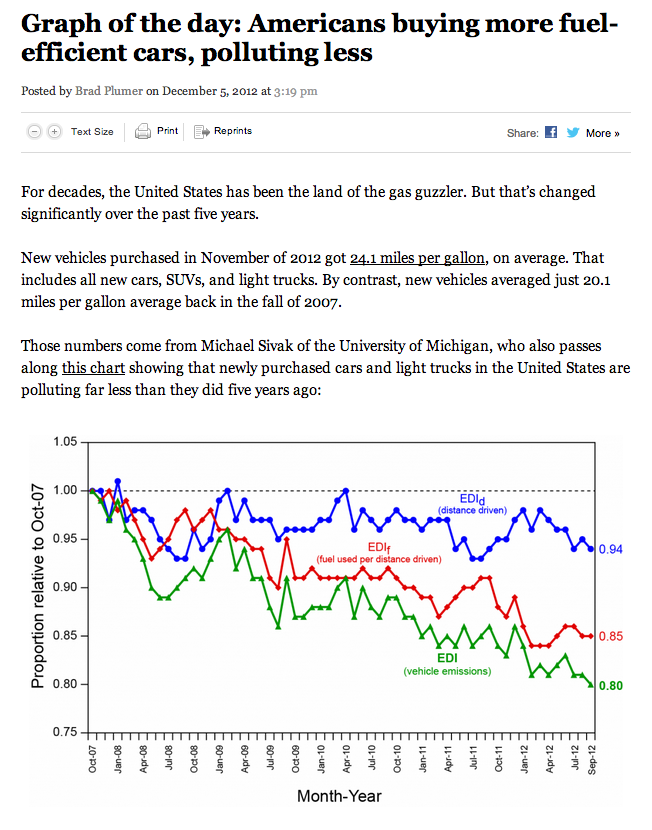













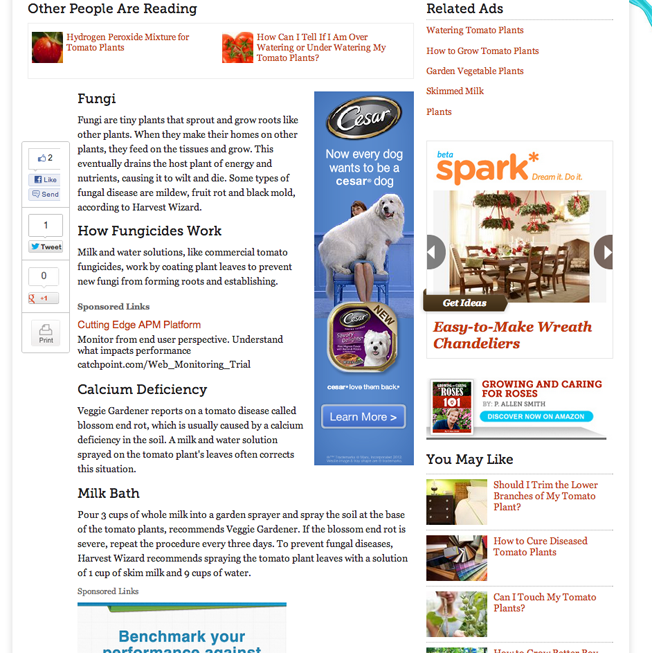
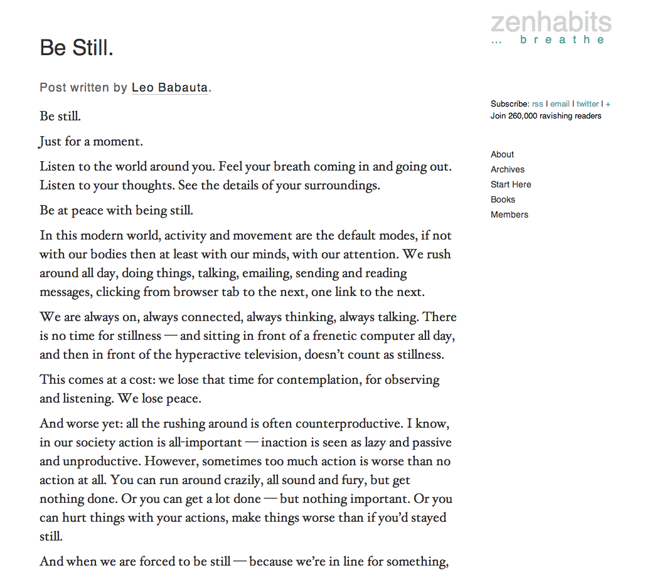
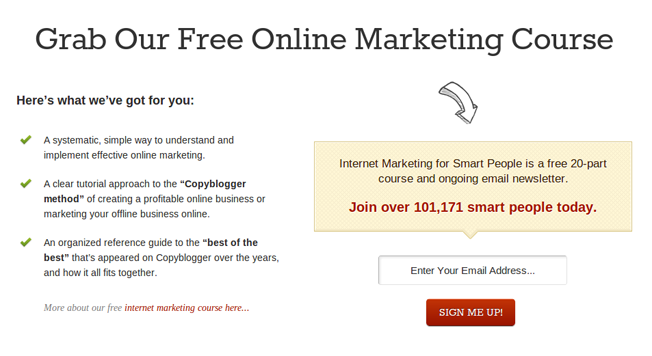


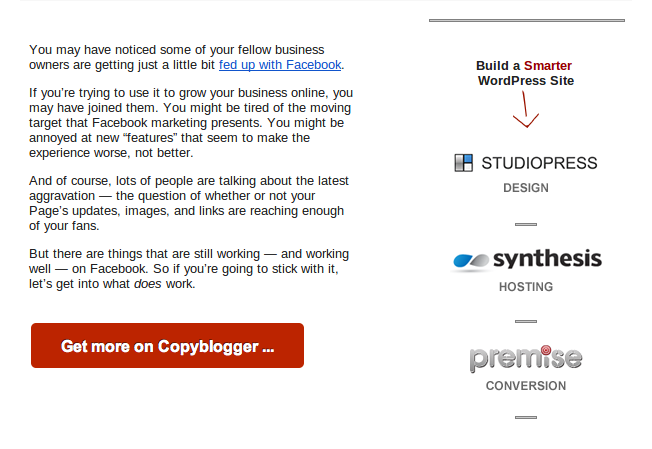
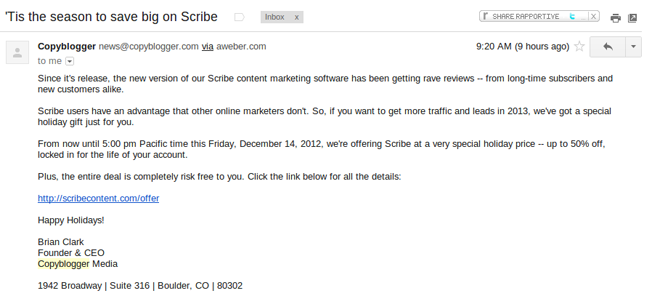

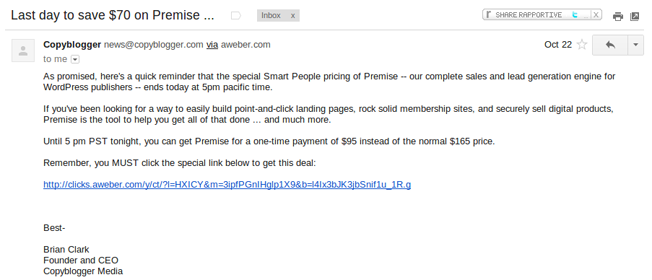

Comments (28)